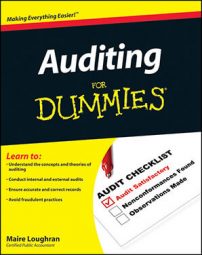You initially evaluate going-concern when deciding to accept a company as an audit client. You reevaluate the client’s ability to continue as a going-concern as you wrap up the audit. The term going-concern means that your audit client will continue to operate indefinitely; a benchmark for indefinitely is at least 12 months past the balance sheet date.
To be deemed a going-concern, a company must be able to generate and/or raise enough cash to pay its operating expenses and make appropriate payments on debt. Directors of publicly traded firms must explicitly state in their financial statements (verified through your independent audit) that they have taken all reasonable steps to ensure the company’s continuing operation.
To make your final going-concern assessment, you reconsider the company’s ability to remain in business. To make this evaluation, you check out negative financial trends and consider the effect that outside events have on the continuing success of the company. You combine this analysis with the information you glean during your audit of the business and financing processes to arrive at a conclusion.
In trend analysis, you compare information on the client’s current financial statements to prior years’ financial statements and to comparable industry ratios. Negative financial trends means the company’s ratios show cash flow and company performance is getting worse instead of better.
You want to check to see what possible effect these negative financial trends have on the company’s continuing success. To do trend analysis, you work with three basic ratios:
Current ratio: Divide current assets by current liabilities to get the current ratio. This ratio measures the company’s ability to pay its short-term debt with liquid assets, which are assets easily converted to cash.
Rather than just look at the year-end current ratio, you want to evaluate the current ratio as a continuing trend, which means to check it out for each month of the year under audit and any available months subsequent to the balance sheet date. That’s because the company may have opted to make unusual cash disbursements at year-end that aren’t indicative of the business’s overall health.
Debt ratio: Total liabilities divided by total assets provides the company’s debt ratio. If total debt is more than total assets (your ratio results in 1 or more), the company is insolvent. In that case, you have a significant issue with the company’s going-concern.
Net income to net sales: This ratio measures how well the company is managing its expenses. Consider your own personal finances. If you gross more than $200,000 a year, you’re in the upper stratum of earning power in the United States. But if your personal living expenses total $210,000, you could be headed toward bankruptcy.
Your audit client could have net sales (gross sales less sales returns and allowances) of a gazillion dollars, but if the net income is a low figure or a negative (net loss), the company may have going-concern issues. Again, doing trend analysis can help you determine whether the problem is an anomaly that will likely reverse in the subsequent year.

